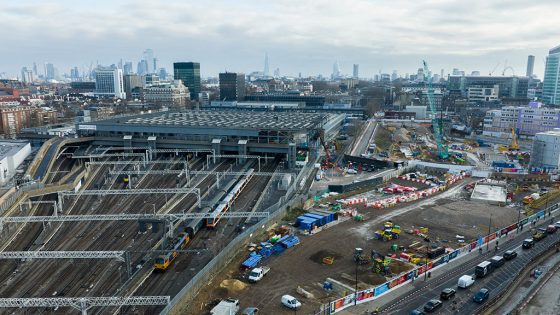Lendlease will work up new plans for development around London’s Euston Station, the government confirmed in today’s Spring Budget, amid a growing rift over the shape of the scheme.
The contractor was appointed as master developer for the site in 2018, but uncertainty over its role emerged after the government withdrew public funding for the HS2 link from Old Oak Common to Euston at the Conservative Party conference last year.
However, Budget documents published today said: “The government is working with Lendlease – the Euston Master Development Partner – and the London Borough of Camden to identify parts of the station site for early release and development in coming months, and progressing plans to realise the vision for an internationally-leading life-sciences hub at the heart of the Euston Quarter.”
The government said it would set up a “ministerial taskforce” to oversee the next stages of delivery, set strategic direction and “facilitate” decision making.
The government will also provide £4.2bn for a new Euston Housing Delivery Group to explore options to deliver ambitious housing opportunities and regeneration in the Euston area.
Lendlease’s European chief executive Andrea Ruckstuhl said: “Bringing forward the first plots of land for development in the coming months will enable us to push ahead, drive this project forward and make a lasting impact on an area where we have a golden opportunity to create new jobs in the innovation sector and build much-needed new homes.
“The release of land so that work can begin will be a significant milestone for a once-in-a-generation project that will be of huge benefit for local communities, London and the whole UK.”
However, the government’s desire to see 10,000 homes built around Euston are potentially undeliverable, according to an economic impact assessment published by Camden Council on Tuesday (5 March).
The report, which was modelled on a development scenario developed by the council, Lendlease and other partners, said there were “questions about the basis for such figures”.
It said: “The complexity of building above and around the stations, coupled with restrictions on building height arising from London’s protected lines of sight under the London View Management Framework planning regulations, impose limitations on potential development in the area.”
The report outlined a “clear preference for a mixed-use regeneration scheme, emphasising the delivery of houses and affordable homes, coupled with retail spaces, commercial areas with a Knowledge Quarter emphasis, and open spaces”.
It said that such a plan could generate £3.4bn from construction activity by 2053 from an initial investment of £4.2bn.
The report proposed that development around the station should include:
- 470,000 square metres of commercial development, with up to 30 per cent for life sciences.
- 2,100-2,500 homes including up to 1,200 affordable.
- 33,000 square metres of retail space.
The development scenario covers three sites – one adjacent to the station, one in the northern approaches to the station, plus development over the station itself.
It also encompasses three areas not within the HS2 site – a former school, a Royal Mail site, plus “plots” within a neighbouring council-owned estate, “subject to resident engagement”.
The Spring Budget also reconfirmed the government’s commitment to delivering a privately financed station for HS2.
A £1.3bn contract to build the station was initially awarded to a Mace/Dragados joint venture by client HS2 Ltd.
However, the autumn announcement saw responsibility for the site removed from HS2 Ltd, the publicly-owned firm delivering the high-speed rail link.

